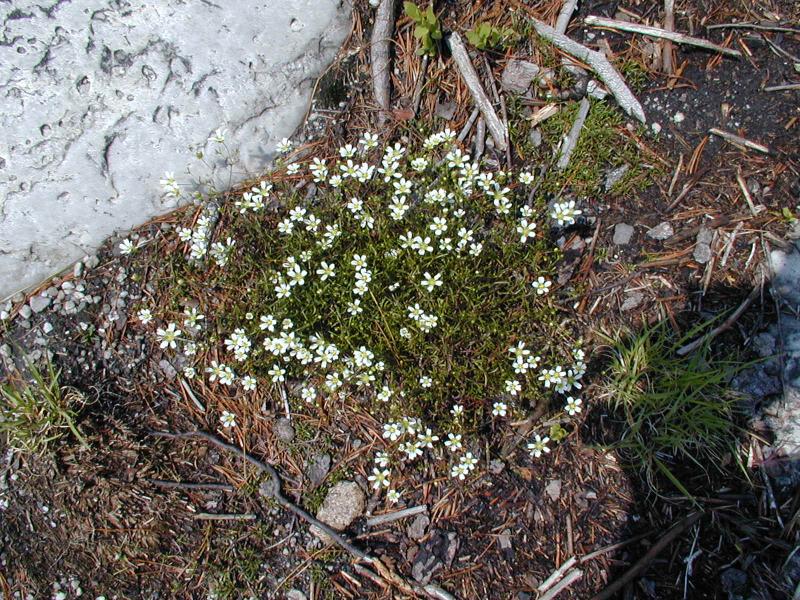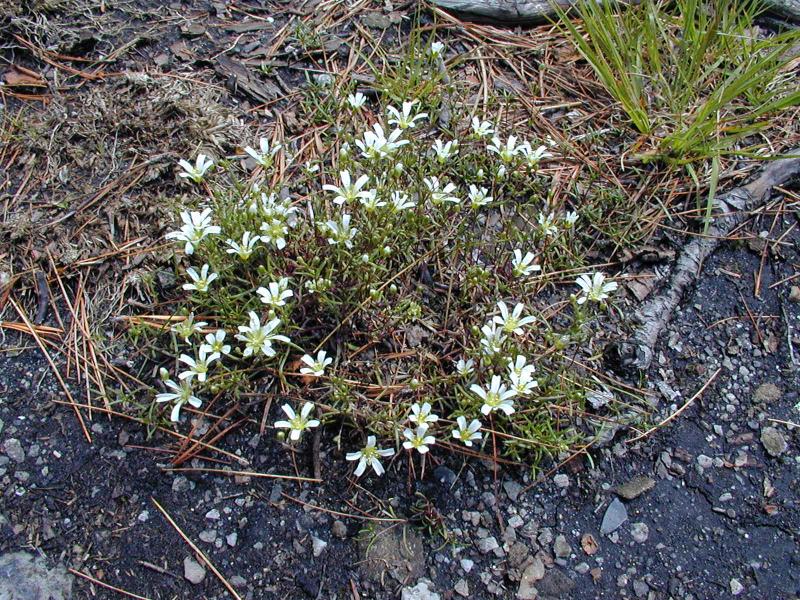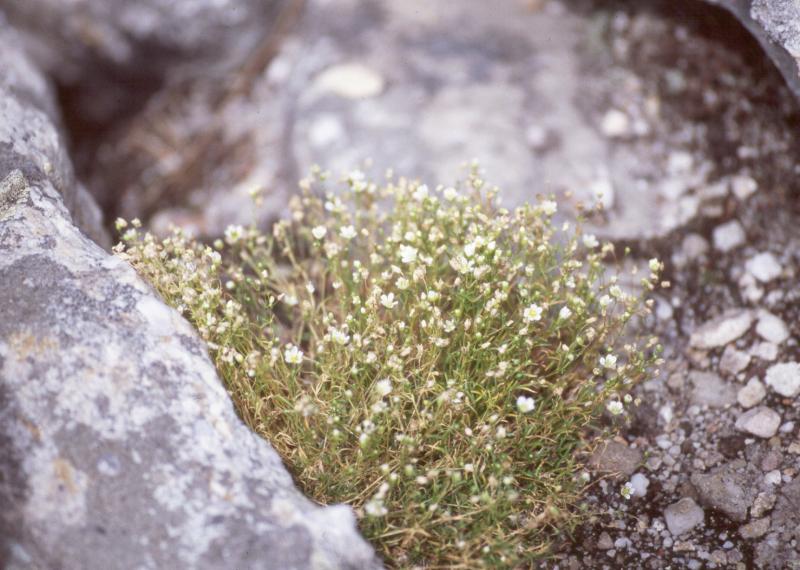Appalachian Sandwort
Mononeuria glabra (Michx.) Dillenb. & Kadereit
- Class
- Dicotyledoneae (Dicots)
- Family
- Caryophyllaceae (Pink Family)
- State Protection
- Rare
A plant listed as Rare by New York State. Removal or damage without the consent of the landowner is prohibited.
- Federal Protection
- Not Listed
- State Conservation Status Rank
- S3
Vulnerable in New York - Vulnerable to disappearing from New York due to rarity or other factors (but not currently imperiled); typically 21 to 80 populations or locations in New York, few individuals, restricted range, few remaining acres (or miles of stream), and/or recent and widespread declines.
- Global Conservation Status Rank
- G4
Apparently Secure globally - Uncommon in the world but not rare; usually widespread, but may be rare in some parts of its range; possibly some cause for long-term concern due to declines or other factors.
Summary
Did you know?
This "winter annual" germinates in the fall and overwinters as a vegetative plant. It flowers and fruits in the spring while temperatures are still cool and before its rocky habitat becomes searingly hot in the summer. In the Shawangunk Mountains the range of this species overlaps with the range of its northern cousin, mountain sandwort, Minuartia groenlandica.
State Ranking Justification
There are 14 existing populations and one historical population. These populations are limited to a small area in the northern Shawangunks but most have good to excellent viability with many individuals. Some populations have over 1000 plants and are protected in the state park or preserve.
Short-term Trends
All evidence indicates that this plant has had a similar range and abundance for at least the past 50-100 years, and probably longer. There is no reason to think that this will change much in the near future.
Long-term Trends
There are only a handful of historical collections, all from the northern Shawangunk Mountains. There is not enough evidence to determine if this plant is more common within the Shawangunks today than at earlier times or if botanists simply did not collect this plant often. Most likely, this plant has a similar range and abundance today as it had prior to European settlement.
Conservation and Management
Threats
This plant is able to tolerate limited disturbance. Most of our known populations are located within protected landscapes. At this time, few if any threats are known.
Conservation Strategies and Management Practices
This plant seems very tolerant of limited disturbance and foot traffic. As best possible, limiting direct impacts is encouraged. The plant does need open sun, so some populations may benefit from tree removal.
Research Needs
More research needs to be done into the exact distribution of this plant and its closely related sandwort Minuartia groenlandica at Sam's Point.
Habitat
Habitat
A plant of dry, usually flat, conglomerate acidic bedrock (usually granitic bedrock, Shawangunk conglomerate, or sandstone formations) with little soil and open sunlight. These populations are often located near the top of cliff areas or open exposures through pitch pine communities (New York Natural Heritage Program 2004). Exposed sandstone rocks (Rhoads and Block 2000). Foothills and lower mountains (Arenaria groenlandica: Gleason and Cronquist, 1991). Mountains with granitic or siliceous rock, wooded ledges, and hills (Arenaria groenlandica var. glabra: Fernald, 1970).
Associated Ecological Communities
- Dredge spoil lake shore
A lake shore or pond shore that is composed of dredge spoils. The vegetation may be sparse.
- Dwarf pine ridges
(guide)
A woodland community dominated by dwarf individuals of pitch pine and black huckleberry, which occurs on flat-topped summits of rocky ridges. The bedrock is a white quartzite conglomerate; soils are very thin, and they are rich in organic matter from litter that has accumulated on the bedrock.
- Pitch pine-oak-heath rocky summit
(guide)
A community that occurs on warm, dry, rocky ridgetops and summits where the bedrock is non-calcareous (such as quartzite, sandstone, or schist), and the soils are more or less acidic. This community is broadly defined and includes examples that may lack pines and are dominated by scrub oak and/or heath shrubs apparently related to fire regime.
- Pitch pine-oak-heath woodland*
(guide)
A pine barrens community that occurs on well-drained, infertile, sandy soils. The structure of this community is intermediate between a shrub-savanna and a woodland. Pitch pine and white oak are the most abundant trees.
- Unpaved road/path
A sparsely vegetated road or pathway of gravel, bare soil, or bedrock outcrop. These roads or pathways are maintained by regular trampling or scraping of the land surface. The substrate consists of the soil or parent material at the site which may be modified by the addition of local organic material (woodchips, logs, etc.) or sand and gravel. Abandoned railroad beds where tracks have been removed are included here. One characteristic plant is path rush.
* probable association but not confirmed.
Associated Species
- Comptonia peregrina (sweet-fern)
- Danthonia spicata (poverty grass)
- Deschampsia flexuosa
- Pinus rigida (pitch pine)
- Polytrichum commune
- Quercus ilicifolia (scrub oak, bear oak)
- Quercus montana (chestnut oak)
- Schizachyrium scoparium
- Vaccinium myrtilloides (velvet-leaved blueberry)
- Vaccinium pallidum (hillside blueberry)
Range
New York State Distribution
This low-growing perennial is currently known from Ulster County in the Shawangunk Ridge and Greene County in the Catskill Mountains. There are also historical records from Sullivan and Orange counties.
Global Distribution
Most common in the mountains of Georgia, Tennessee, and North Carolina. Also locally distributed north on granitic or siliceous rock of the Shawangunk and Catskill Mountains of New York, wooded ledges in Connecticut and Rhode Island, hills of New Hampshire and Maine, and along the coast in Maine.
Identification Comments
General Description
This is a small delicate wildflower no more than 1-4 dm tall with an open clump of many, arching, usually unbranched, wiry stems. Each stem is topped by 9-15 small flowers with five separate white petals 6-10 mm long. The 2-3 pairs of short and very narrow leaves arise opposite each other.
Identifying Characteristics
A delicate perennial or annual with stems 10-20 cm long and seldom matted. The stems are simple or forked with few, if any, leafy basal shoots. The leaves are soft and linear. There are 9-15 flowers per cyme. The sepals are 3-4 mm long, oblong to oblong-ovate, obtuse or acutish, and faintly 1-nerved. The petals are 4-8 mm long.
Best Life Stage for Proper Identification
A flowering stem with a complete description of the habitat and locality is necessary for proper identification.
Similar Species
Mountain sand-wort (Minuartia groenlandica) is mat-forming to 15 cm and has 3-7 flowers per cyme. The sepal is 4-5.5 mm long and the petal is 6-10 mm long. This is mainly a mountain plant of northern habitats. Pine-barren sand-wort (Minuartia caroliniana) is restricted to the sand dunes of Long Island. Rock sand-wort (Minuartia michauxii) has acute sepals that are prominently ribbed and it has secondary leaves in the axils of the primary leaves.
Best Time to See
Flowers may be present throughout the growing season from mid-May to the first frost. Surveys may be conducted anytime during the growing season.
- Vegetative
- Flowering
- Fruiting
The time of year you would expect to find Appalachian Sandwort vegetative, flowering, and fruiting in New York.
Appalachian Sandwort Images
Taxonomy
Appalachian Sandwort
Mononeuria glabra (Michx.) Dillenb. & Kadereit
- Kingdom Plantae
- Phylum Anthophyta
- Class Dicotyledoneae
(Dicots)
- Order Caryophyllales
- Family Caryophyllaceae (Pink Family)
- Order Caryophyllales
- Class Dicotyledoneae
(Dicots)
- Phylum Anthophyta
Additional Common Names
- Appalachian Stitchwort
- Mountain Sandwort
- Smooth Mountain Sandwort
- Smooth Sandwort
Synonyms
- Alsinopsis glabra (Michx.) Small [in part.]
- Arenaria glabra Michx.
- Arenaria groenlandica var. glabra (Michx.) Fern.
- Minuartia glabra (Michx.) Mattf.
- Minuartia groenlandica ssp. glabra (Michx.) Á. Löve & D. Löve
- Sabulina glabra (Michx.) Small
Additional Resources
Best Identification Reference
Gleason, Henry A. and A. Cronquist. 1991. Manual of Vascular Plants of Northeastern United States and Adjacent Canada. The New York Botanical Garden, Bronx, New York. 910 pp.
Other References
Fernald, M.L. 1950. Gray's manual of botany. 8th edition. D. Van Nostrand, New York. 1632 pp.
Holmgren, Noel. 1998. The Illustrated Companion to Gleason and Cronquist's Manual. Illustrations of the Vascular Plants of Northeastern United States and Adjacent Canada. The New York Botanical Garden, Bronx, New York.
Mitchell, Richard S. and Gordon C. Tucker. 1997. Revised Checklist of New York State Plants. Contributions to a Flora of New York State. Checklist IV. Bulletin No. 490. New York State Museum. Albany, NY. 400 pp.
New York Natural Heritage Program. 2010. Biotics database. New York Natural Heritage Program. New York State Department of Environmental Conservation. Albany, NY.
New York Natural Heritage Program. 2024. New York Natural Heritage Program Databases. Albany, NY.
Reschke, Carol. 1990. Ecological communities of New York State. New York Natural Heritage Program, New York State Department of Environmental Conservation. Latham, NY. 96 pp. plus xi.
Rhoads, Ann F. and Timothy A. Block. 2000. The Plants of Pennsylvania, an Illustrated Manual. University of Pennsylvania Press, Philadelphia, PA.
Weldy, T. and D. Werier. 2010. New York flora atlas. [S.M. Landry, K.N. Campbell, and L.D. Mabe (original application development), Florida Center for Community Design and Research http://www.fccdr.usf.edu/. University of South Florida http://www.usf.edu/]. New York Flora Association http://newyork.plantatlas.usf.edu/, Albany, New York
Links
About This Guide
Information for this guide was last updated on: December 22, 2004
Please cite this page as:
New York Natural Heritage Program. 2024.
Online Conservation Guide for
Mononeuria glabra.
Available from: https://guides.nynhp.org/appalachian-sandwort/.
Accessed July 26, 2024.


